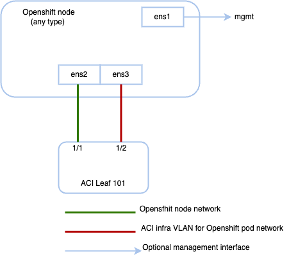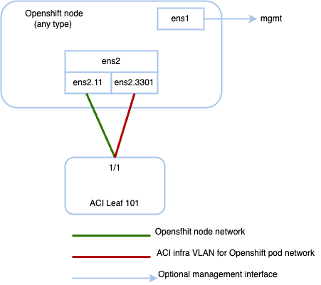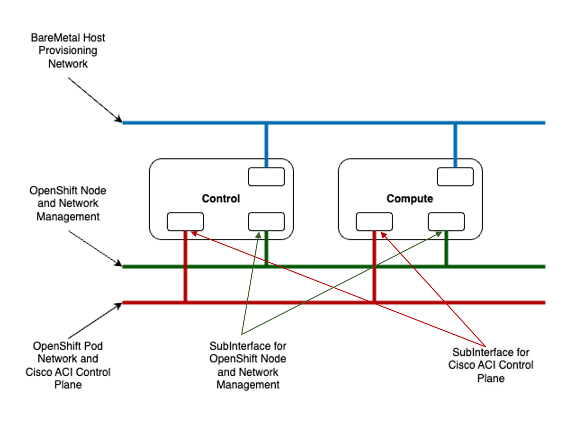Installing Agent Based OpenShift 4.15 on a Bare Metal Server
Table of contents
- Agent-Based OpenShift 4.15 on Bare Metal
- Requirements for supporting Agent Based OpenShift 4.15 on a Bare Metal Server
- Installation Process
- Scaling Agent-Based Installation with the Bare Metal Operator
- Known Caveats
Agent-Based OpenShift 4.15 on Bare Metal
This document pertains to installing OCP with the ACI CNI. However, to identify and resolve issues in your infrastructure not related to the ACI CNI, see the relevant installation guide to first install OCP on your bare metal nodes using the default OVN Kubernetes. You can check the OpenShift 4.15 container platform documentation.
Note This document can not be used standalone. This document should be used along with the Red Hat OpenShift 4.15 Installing an on-premise cluster with the Agent-based Installer document to perform the OpenShift cluster installation.
Requirements for supporting Agent Based OpenShift 4.15 on a Bare Metal Server
At least two network interfaces are required for bare metal nodes, one
for the node network, and the second for the pod network. The design
separates OpenShift node traffic from the pod traffic.
There are two options available to achieve separation, resulting in
control and compute machines each having two network interfaces:
- Separate physical interface for node and infra networks

The first interface is used for the node network and the second one is used for the pod network. The second interface also carries Cisco ACI control plane traffic. A VLAN tagged subinterface can be configured on the second interface to carry the cluster's pod traffic and also the Cisco ACI control plane traffic.
- Single Sub interface for both node and infra networks.

The node network and pod network are configured as VLAN subinterface of either bond0 or physical NIC. You can configure the server with additional VLAN(s) for management purpose or use the node network for management network. The design might be dependent on the server provisioning method (PXE or manual ISO boot).
#
Installation Process

The following sections detail the steps required to install the OpenShift cluster using the ACI CNI.
-
Configuring the OpenShift Installer
-
Configuring ACI Infra and CNI
-
Preparing Custom Network Configuration for OpenShift Nodes
Configuring the OpenShift Installer
Use this procedure to configure the OpenShift installer. The installation will use 3 node cluster (control will have scheduling enabled). For scaling nodes post installation please refer to the section “Scaling Agent-Based Installation with the Bare Metal Operator”
Before you begin
Download the OpenShift installer and OC client.
- For details of the location from where you can download the installer, see the OpenShift 4.15 document titled, Installing an on-premise cluster with the Agent-based Installer
Procedure
- Create the install-config.yaml file.
```
apiVersion: v1
baseDomain: noiro.local
proxy:
httpsProxy:
httpProxy: noProxy: compute: - name: worker
replicas: 0
controlPlane:
name: master
replicas: 3
metadata:
name: ocpbm1
networking:
machineNetwork:
- cidr: 192.168.1.0/24 clusterNetwork:
- cidr: 10.2.0.0/16 hostPrefix: 23 networkType: CiscoACI serviceNetwork:
- 172.30.0.0/16 platform: baremetal: apiVIPs:
- 192.168.1.30 ingressVIPs:
- 192.168.1.29
fips: false
pullSecret:
sshKey:
- name: worker
replicas: 0
controlPlane:
name: master
replicas: 3
metadata:
name: ocpbm1
networking:
machineNetwork:
2. Create the agent-config.yaml file
apiVersion: v1alpha1 kind: AgentConfig metadata: name: ocpbm1 rendezvousIP: 192.168.1.3 AdditionalNTPSources:
- time.cisco.com hosts:
- hostname: ocpbm1-master1
role: master
interfaces:
- name: ens160
macAddress: 00:50:56:97:16:db
networkConfig:
interfaces:
- name: ens160 mtu: 9000 ipv4: enabled: false ipv6: enabled: false
- name: node type: vlan mtu: 9000 state: up vlan: base-iface: ens160 id: 11 ipv4: enabled: true address: - ip: 192.168.1.3 prefix-length: 24 dhcp: false ipv6: enabled: false
- name: infra
type: vlan
mtu: 9000
state: up
vlan:
base-iface: ens160
id: 3301
ipv4:
enabled: true
dhcp: true
ipv6:
enabled: false
dns-resolver:
config:
server:
- 192.168.1.2 routes: config:
- destination: 0.0.0.0/0 next-hop-address: 192.168.1.1 next-hop-interface: node
- destination: 224.0.0.0/4 next-hop-interface: infra
- name: ens160
macAddress: 00:50:56:97:16:db
networkConfig:
interfaces:
- hostname: ocpbm1-master2
role: master
interfaces:
- name: ens160
macAddress: 00:50:56:97:63:de
networkConfig:
interfaces:
- name: ens160 mtu: 9000 ipv4: enabled: false ipv6: enabled: false
- name: node type: vlan mtu: 9000 state: up vlan: base-iface: ens160 id: 11 ipv4: enabled: true address: - ip: 192.168.1.4 prefix-length: 24 dhcp: false ipv6: enabled: false
- name: infra
type: vlan
mtu: 9000
state: up
vlan:
base-iface: ens160
id: 3301
ipv4:
enabled: true
dhcp: true
ipv6:
enabled: false
dns-resolver:
config:
server:
- 192.168.1.2 routes: config:
- destination: 0.0.0.0/0 next-hop-address: 192.168.1.1 next-hop-interface: node
- destination: 224.0.0.0/4 next-hop-interface: infra
- name: ens160
macAddress: 00:50:56:97:63:de
networkConfig:
interfaces:
- hostname: ocpbm1-master3
role: master
interfaces:
- name: ens160
macAddress: 00:50:56:97:00:e5
networkConfig:
interfaces:
- name: ens160 mtu: 9000 ipv4: enabled: false ipv6: enabled: false
- name: node type: vlan mtu: 9000 state: up vlan: base-iface: ens160 id: 11 ipv4: enabled: true address: - ip: 192.168.1.5 prefix-length: 24 dhcp: false ipv6: enabled: false
- name: infra
type: vlan
mtu: 9000
state: up
vlan:
base-iface: ens160
id: 3301
ipv4:
enabled: true
dhcp: true
ipv6:
enabled: false
dns-resolver:
config:
server:
- 192.168.1.2 routes: config:
- destination: 0.0.0.0/0 next-hop-address: 192.168.1.1 next-hop-interface: node
- destination: 224.0.0.0/4 next-hop-interface: infra
- name: ens160
macAddress: 00:50:56:97:00:e5
networkConfig:
interfaces:
## Configuring ACI Infra and CNI
Use this procedure for configuring ACI infra and CNI using
acc-provision.
### Procedure
Sample ACI configuration:
Configuration for ACI Fabric
aci_config: system_id: openupi # Every opflex cluster on the same fabric must have a distinct ID apic_hosts:
-
# List of APIC hosts to connect to for APIC API access apic_login: username: password:
vmm_domain: # Kubernetes VMM domain configuration
encap_type: vxlan # Encap mode: vxlan or vlan
mcast_range: # Every vxlan VMM on the same fabric must use a distinct range
start: 225.115.1.1
end: 225.115.255.255
# The following resources must already exist on the APIC,
# this is a reference to use them
aep:
agent_based_installer: # This is to enable agent_based configuration enable: true
# Networks used by Kubernetes net_config: # This should also exist, the provisioning tool does not create it node_subnet: 192.168.1.1/24 # Subnet to use for nodes pod_subnet: 10.2.0.1/16 # Subnet to use for Kubernetes Pods extern_dynamic: 10.3.0.1/16 # Subnet to use for dynamically allocated external services extern_static: 10.4.0.1/16 # Subnet to use for statically allocated external services node_svc_subnet: 10.5.0.1/16 # Subnet to use for service graph kubeapi_vlan: 11 # The VLAN used by the internal physdom for nodes service_vlan: 21 infra_vlan: 3301 # The VLAN used for external LoadBalancer services
**Note** The `\*.apps.\<cluster_name\>.\<base_domain\>` records in the user-provisioned DNS should refer to the same IP address used in the ingressVIPs in install-config.yaml
Customize the sample `acc-provision` input file shown above as per your requirements. Then, install the latest acc-provision package from https://pypi.org/project/acc-provision/ and run `pip install acc-provision` .
Run the acc-provision as follows:
$ ~/openupi$ pwd
/home/
This generates a new aci_deployment.yaml.tar.gz file which contains the ACI CNI manifests, and is used later during the OpenShift installation.
## Preparing Custom Network Configuration for OpenShift Nodes
ACI CNI requires additional VLANs to be extended towards each OpenShift
node. Additional VLANS are required for all master and worker nodes.
You can configure additional VLANs on the interface that will be
configured with the node network subnet or can be configured on an
additional physical interface on the hosts.
The available option to configure network interface of a host is to
provide the configuration in agent-config.yaml in NMState format. See
the [Configuring the OpenShift Installer](#configuring-the-openshift-installer) creation of
agent-config.yaml
###
### Agent-Config File Modification
**Before you begin**
The agent-config file, with additional NIC configuration, required to
extend the Cisco ACI internal network (Infra VLAN) up to the server
level. This interface is used to carry VxLAN traffic from OVS towards
the ACI leaf switch with an appropriate tag for the pod network. In this
document, we will opt for the second choice:
- Single Sub interface for both node and infra networks.
apiVersion: v1alpha1 kind: AgentConfig metadata: name: ocpbm1 rendezvousIP: 192.168.1.3. -> A AdditionalNTPSources:
- time.cisco.com hosts: -> B
- hostname: ocpbm1-master1 -> C
role: master
interfaces:
- name: ens160
macAddress: 00:50:56:97:16:db
networkConfig: -> D
interfaces:
- name: ens160 mtu: 9000 ipv4: enabled: false ipv6: enabled: false
- name: node type: vlan mtu: 9000 state: up vlan: base-iface: ens160 id: 11 ipv4: enabled: true address: - ip: 192.168.1.3 prefix-length: 24 dhcp: false ipv6: enabled: false
- name: infra
type: vlan
mtu: 9000
state: up
vlan:
base-iface: ens160
id: 3301
ipv4:
enabled: true
dhcp: true
ipv6:
enabled: false
dns-resolver:
config:
server:
- 192.168.1.2 routes: config:
- destination: 0.0.0.0/0 next-hop-address: 192.168.1.1 next-hop-interface: node
- destination: 224.0.0.0/4 next-hop-interface: infra
- name: ens160
macAddress: 00:50:56:97:16:db
networkConfig: -> D
interfaces:
A. This IP address is used to determine which node performs the
bootstrapping process as well as running
the assisted-service component. You must provide the rendezvous IP
address when you do not specify at least one host's IP address in
the networkConfig parameter. If this address is not provided, one IP
address is selected from the provided hosts\' networkConfig
B. Host configuration. The number of hosts defined must not exceed the
total number of hosts defined in the install-config.yaml file, which
is the sum of the values of
the compute.replicas and controlPlane.replicas parameters
C. Overrides the hostname obtained from either the Dynamic Host
Configuration Protocol (DHCP) or a reverse DNS lookup. Each host
must have a unique hostname supplied by one of these methods
D. Configures the network interface of a host in NMState format.
##### Procedure
**Step 1.** Create a root folder for your cluster.
`cd /home/<user>/openupi mkdir upi`
**Step 2.** Copy the `install-config.yaml`, `agent-config.yaml` in the newly created upi folder.
**Step 3.** Create the openshift directory
`mkdir -p /home/<user>/openupi/upi/openshift`
**Step 4.** Extract all the ACI manifest files in upi/openshift/.
`tar -xvf aci_deployment.yaml.tar.gz -C upi/openshift/`
**Step 5.** Create the iso image.
`openshift-install agent create image --dir=upi --log-level debug`
**Step 6.** Boot the `agent.x86_64.iso` image on the bare metal machines
The `agent.x86_64.iso` is now ready and can be copied to your HTTP server, so they can be served to your nodes. The agent.x86_64.iso file will be consumed by every node and the network configuration for each node will be recognized based on the mac-address mention in NMState configuration for each node.
## Updating the Default Ingress Controller
For updating the default Ingress Controller publish strategy to use the
ACI Loadbalancer, log in as a user with cluster-admin privileges and run
the following:
oc replace –force –wait –filename - «EOF apiVersion: operator.openshift.io/v1 kind: IngressController metadata: namespace: openshift-ingress-operator name: default spec: endpointPublishingStrategy: type: LoadBalancerService loadBalancer: scope: External EOF
For more details, see the *Configuring the Default Ingress Controller
for your Cluster to be Internal* section in the *Ingress Operator in
OpenShift Container Platform Red Hat* guide.
## Scaling Agent-Based Installation with the Bare Metal Operator
The below method can be used to add workers or scale nodes in a cluster
**Step 1.** Power off the bare metal node by using the baseboard
management controller (BMC), and ensure it is off.
**Step 2.** Apply configuration file for the bare metal node, use one of
the following example bmh.yaml files, replacing values in the YAML to
match your environment:
apiVersion: metal3.io/v1alpha1 kind: Provisioning metadata: finalizers:
- provisioning.metal3.io name: provisioning-configuration spec: preProvisioningOSDownloadURLs: {} provisioningMacAddresses:
-
-
-
provisioningNetwork: Managed provisioningIP: 192.168.254.30 provisioningNetworkCIDR: 192.168.254.0/24 provisioningDHCPRange: 192.168.254.3,192.168.254.10 provisioningInterface: ens70s0f1 --- apiVersion: v1 kind: Secret metadata: name: bmc-credentials namespace: openshift-machine-api data: username: password: --- apiVersion: v1 kind: Secret metadata: name: bm-compute-0-netconfig namespace: openshift-machine-api type: Opaque stringData: nmstate: | interfaces: - name: ens160 mtu: 9000 ipv4: enabled: false ipv6: enabled: false
- name: node type: vlan mtu: 9000 state: up vlan: base-iface: ens160 id: 11 ipv4: enabled: true address: - ip: 192.168.1.6 prefix-length: 24 dhcp: false ipv6: enabled: false
- name: infra
type: vlan
mtu: 9000
state: up
vlan:
base-iface: ens160
id: 3301
ipv4:
enabled: true
dhcp: true
ipv6:
enabled: false
dns-resolver:
config:
server:
- 192.168.1.2 routes: config:
- destination: 0.0.0.0/0 next-hop-address: 192.168.1.1 next-hop-interface: node
- destination: 224.0.0.0/4
next-hop-interface: infra
—
apiVersion: metal3.io/v1alpha1
kind: BareMetalHost
metadata:
name: compute-0
namespace: openshift-machine-api
spec:
automatedCleaningMode: metadata
online: true
bootMACAddress:
bmc: address: :// credentialsName: bmc-credentials disableCertificateVerification: True preprovisioningNetworkDataName: bm-compute-0-netconfig
**Note:** To enable multiple worker nodes, users must generate distinct
netconfig secrets for each node. Additionally, it\'s crucial to note
that deleting a BaremetalHost object will also remove the associated
secrets. Therefore, when utilizing multiple BaremetalHost objects,
ensure that the credential secret is retained for the non-deleted
BaremetalHost instances to maintain proper functionality
**Step 3.** Check the respective objects created
- Provisioning Network: Private network used for PXE booting.
- Secret bmc-credentials: Credentials for the bmc access
- Secret bm-compute-0-netconfig: Custom Network configuration for
worker node
- BareMetalHost compute-0: Configuration to manage the baremetal node
**Step** **4.** Scale up the number of replicas to match the number of
available bare metal hosts:
oc scale machineset -n openshift-machine-api
What to do next
Proceed with the tracking and verifying installation progress of the cluster; see the Redhat OpenShift 4.15 document (mentioned earlier in the chapter).
Known Caveats
-
Assisted installer cluster installation fails with IP collision validation, due to a Porxy ARP request https://issues.redhat.com/browse/OCPBUGS-43352
Resolution
- Start the installation as usual
-
Get the Cluster ID:
curl -s http://rendezvousIP:8090/api/assisted-install/v2/clusters/ | jq ".[0].api_vips[0].cluster_id" - Disable Validations
curl rendezvousIP:8090/api/assisted-install/v2/clusters/<cluster-id>/ignored-validations -X 'PUT' -H 'accept: application/json' -H 'Content-Type: application/json' -d '{ "cluster-validation-ids": "[\"all\"]", "host-validation-ids": "[\"all\"]" }' - If you observe the message below after running the previous step, wait until the installation reaches the stage where this error starts appearing
{"code":"400","href":"","id":400,"kind":"Error","reason":"Cluster 11467e69-dbad-4c70-a62c-ae2b83ba47e5 is in installing state, cluster can be updated only in one of [insufficient ready pending-for-input adding-hosts]"}